Economic Valuation of Carbon Storage and Sequestration in Retezat National Park, Romania
Abstract
1. Introduction
2. Materials and Methods
2.1. Study Area
2.2. Data and Methods
3. Results
3.1. Carbon Stock and Sequestration in Retezat Mountains Park
3.2. Estimated Carbon Stored Using Terrestrial Laser Scanner Technology
3.3. Monetary Valuation of Carbon Storage and Sequestration
4. Discussion
5. Conclusions
Author Contributions
Funding
Acknowledgments
Conflicts of Interest
Appendix A
Appendix A.1. Land Use Data
- –
- 3 classes of crown density: 1—from 0–0.3, 2—from 0.4–0.6 and 3—from 0.7–1.
- –
- 7 age classes—1: 0–20 years, 2: 21–40 years, 3: 41–60 years, 4: 61–80 years, 5: 81–100 years, 6: 101–120 years, 7: >120 years.
Appendix A.2. Carbon Pools Values



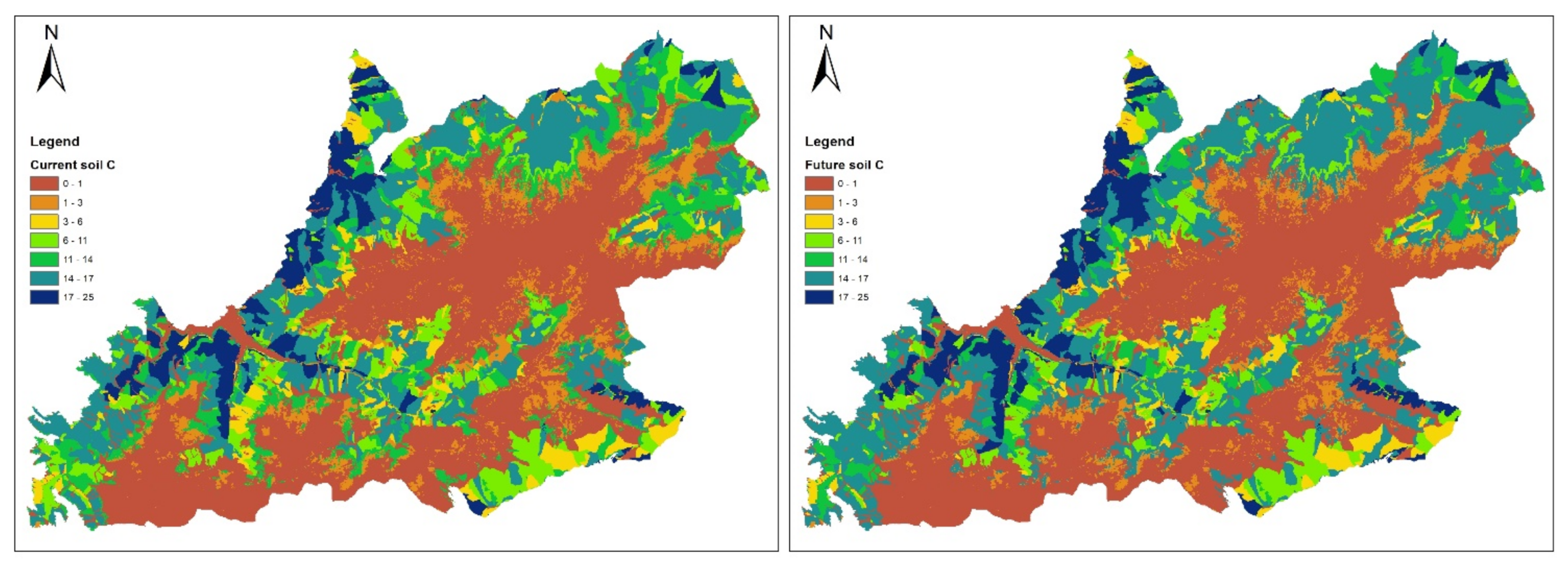
Appendix A.3. Economic Data
- -
- Price/ton of carbon: the price in the currency per metric ton of elementary carbon (not CO2). According to Ecosystem marketplace—a global platform for the transparency of the information in the field of environment and payments for ecosystem services, the average price on the voluntary market in 2018 was 3 $/tCO2 equivalent [34]. In order to reach the price per tonne of carbon, we multiplied the price per tCO2 equivalent with 3.67 coefficient. We come up with a price of 11 $/tonne of carbon, which enters into analysis.
- -
- market discount rate, which reflects the preferences of the society for the immediate benefits compared with future benefits, have been estimated at 7%, a value recommended by the US Government for cost-benefit related environment projects.
- -
- annual rate of change in the price of carbon, a percentage value which adjust the value of the sequestered carbon. After the analysis, we have used 3% as an annual rate of change.
References
- Huang, L.; Zhou, M.; Lv, J.; Chen, K. Trends in global research in forest carbon sequestration: A bibliometric analysis. J. Clean. Prod. 2020, 252, 119908. [Google Scholar] [CrossRef]
- Karsenty, A.; Blanco, C.; Dufour, T. Forest and Climate Change Instruments Related to the United Nations Framework Convention on Climate Change and Their potential for Sustainable Forest Management in Africa; FAO: Rome, Italy, 2003. [Google Scholar]
- Field, C.B.; Barros, V.R.; Dokken, D.J.; Mach, K.J.; Mastrandrea, M.D.; Bilir, T.E.; Chatterjee, M.; Ebi, K.L.; Estrada, Y.O.; Genova, R.C.; et al. (Eds.) Summary for Policymakers. In Climate Change 2014: Mitigation of Climate Change. Contribution of Working Group III to the Fifth Assessment Report of the Intergovernmental Panel on Climate Change; Cambridge University Press: Cambridge, UK; New York, NY, USA, 2014; pp. 1–32. [Google Scholar]
- Mery, G.; Katila, P.; Galloway, G.; Alfaro, R.I.; Kanninen, M.; Lobovikov, M.; Varjo, J. Forests and Society–Responding to Global Drivers of Change; IUFRO World Series; IUFRO: Vienna, Austria, 2010; Volume 25, 509p. [Google Scholar]
- Díaz, S.; Settele, J.; Brondízio, E.S.; Ngo, H.T.; Guèze, M.; Agard, J.; Arneth, A.; Balvanera, P.; Brauman, K.A.; Butchart, S.H.M.; et al. (Eds.) Summary for Policymakers of the Global Assessment Report on Biodiversity and Ecosystem Services of the Intergovernmental Science-Policy Platform on Biodiversity and Ecosystem Services; IPBES Secretariat: Bonn, Germany, 2019; 56p. [Google Scholar] [CrossRef]
- Farley, J. Ecosystem Services: The Economics Debate, Ecosystem Services; Elsevier: Amsterdam, The Netherlands, 2012; Volume 1, pp. 40–49. [Google Scholar] [CrossRef]
- EU Biodiversity Strategy for 2030: Communication from the Commission to the European Parliament, the Council, the European Economic and Social Committee and the Committee of the Regions. 2020. Available online: https://eur-lex.europa.eu/legal-content/EN/TXT/DOC/?uri=CELEX:52020DC0380&from=EN (accessed on 16 October 2020).
- Scarlat, N.; Dallemand, J.F.; Monforti-Ferrario, F.; Nita, V. The role of biomass and bioenergy in a future bioeconomy: Policies and facts. Environ. Dev. 2015, 15, 3–34. [Google Scholar] [CrossRef]
- Olofsson, P.; Kuemmerle, T.; Griffiths, P.; Knorn, J.; Baccini, A.; Gancz, V.; Blujdea, V.; Houghton, R.A.; Abrudan, I.V.; Woodcock, C.E. Carbon implications of forest restitution in post-socialist Romania. Environ. Res. Lett. 2011, 6, 045202. [Google Scholar] [CrossRef]
- Abbas, S.; Irteza, S.M.; Shahzad, N. Approaches of Satellite Remote Sensing for the Assessment of Above-Ground Biomass across Tropical Forests: Pan-tropical to National Scales. Remote Sens. 2020, 12, 3351. [Google Scholar] [CrossRef]
- Harja, D.; Dewi, S.; Heryawan, F.X.; van Noordwijk, M. Forest Carbon-Stock Estimates Based on National Forest Inventory Data; ALLREDDI Brief 02; World Agroforestry Centre (ICRAF) Southeast Asia Program: Bogor, Indonesia, 2011. [Google Scholar]
- Smith, J.E.; Heath, L.S.; Woodbury, P.B. How to estimate forest carbon for large areas from inventory data. J. For. 2004, 102, 25–31. [Google Scholar]
- Grüneberg, E.; Schöning, I.; Riek, W.; Ziche, D.; Evers, J. Carbon Stocks and Carbon Stock Changes in German Forest Soils. In Status and Dynamics of Forests in Germany; Wellbrock, N., Bolte, A., Eds.; Springer Nature Switzerland AG: Cham, Switzerland, 2019. [Google Scholar] [CrossRef]
- Baral, S.K.; Malla, R.; Ranabhat, S. Above-ground carbon stock assessment in different forest types of Nepal. Banko Janakari 2010, 19, 10–14. [Google Scholar] [CrossRef]
- Vicharnakorn, P.; Shrestha, R.; Nagai, M.; Salam, A.; Kiratiprayoon, S. Carbon stock assessment using remote sensing and forest inventory data in Savannakhet, Lao PDR. Remote Sens. 2014, 6, 5452–5479. [Google Scholar] [CrossRef]
- Dieter, M.; Elsasser, P. Quantification and Monetary Valuation of Carbon Storage in the Forests of Germany in the Framework of National Accounting; BFH Institute for Economics Working Paper 2002/8; University of Hamburg: Hamburg, Germany, 2002; 64p. [Google Scholar]
- Banasiak, A.; Bilmes, L.; Loomis, B. Carbon Sequestration in the U.S. National Parks: A Value beyond Visitation; HKS Working Paper No. RWP15-007; Harvard Kennedy School: Cambridge, MA, USA, 2015. [Google Scholar] [CrossRef]
- Kazak, J.; Malczyk, J.; Castro, D.G.; Szewrański, S. Carbon sequestration in forest valuation. Real Estate Manag. Valuat. 2016, 24, 76–86. [Google Scholar] [CrossRef]
- Daily, G. Nature’s Services: Societal Dependence on Natural Ecosystems; Island Press: Washington, DC, USA, 1997; p. 392. [Google Scholar] [CrossRef]
- Valatin, G. Carbon Valuation in Forestry and Prospects for European Harmonization–European Forest Institute Technical Report 97. 2014. Available online: https://efi.int/sites/default/files/files/publication-bank/2018/tr_97.pdf (accessed on 19 October 2020).
- European Green Deal: Communication from the Commission to the European Parliament, the Council, the European Economic and Social Committee and the Committee of the Regions. 2019. Available online: https://eur-lex.europa.eu/legal-content/EN/TXT/DOC/?uri=CELEX:52019DC0640&from=EN (accessed on 15 October 2020).
- Popa, B.; Pascu, M.; Nita, D.M.; Borz, S.A.; Codreanu, C. The Value of Forest Ecosystem Services in Romanian Protected Areas–A Comparative Analysis of Management; Series II; Bulletin of the Transilvania University of Brasov. Forestry, Wood Industry, Agricultural Food Engineering, Transilvania University: Brasov, Romania, 2013; Volume 6, p. 53. [Google Scholar]
- Suh, S.; Johnson, J.A.; Tambjerg, L.; Sim, S.; Broeckx-Smith, S.; Reyes, W.; Chaplin-Kramer, R. Closing yield gap is crucial to avoid potential surge in global carbon emissions. Global Environ. Chang. 2020, 63, 102100. [Google Scholar] [CrossRef]
- Chaplin-Kramer, R.; Sharp, R.P.; Mandle, L.; Sim, S.; Johnson, J.; Butnar, I.; McLachlan, N. Spatial patterns of agricultural expansion determine impacts on biodiversity and carbon storage. Proc. Natl. Acad. Sci. USA 2015, 112, 7402–7407. [Google Scholar] [CrossRef] [PubMed]
- Popa, B.; Borz, S.A.; Nita, M.D.; Ioras, F.; Iordache, E.; Borlea, F.; Abrudan, I.V. Forest ecosystem services valuation in different management scenarios: A case study of the Maramures Mountains. Balt. For. 2016, 22, 327–340. [Google Scholar]
- Sharp, R.; Douglass, J.; Wolny, S.; Arkema, K.; Bernhardt, J.; Bierbower, W.; Chaumont, N.; Denu, D.; Fisher, D.; Glowinski, K.; et al. VEST 3.8.9.post13+ug.ga74679f User’s Guide; The Natural Capital Project, Stanford University, University of Minnesota, The Nature Conservancy, and World Wildlife Fund, Stanford University: Stanford, CA, USA, 2020. [Google Scholar]
- Management Plan of Retezat National Park; Retezat National Park Administration: Hunedoara, Romania, 2013.
- Pflugmacher, D.; Rabe, A.; Peters, M.; Hostert, P. Mapping pan-European land cover using Landsat spectral-temporal metrics and the European LUCAS survey. Remote Sens. Environ. 2019, 221, 583–595. [Google Scholar] [CrossRef]
- Aalde, H.; Gonzalez, P.; Gytarsky, M.; Krug, T.; Kurz, W.A.; Ogle, S.; Raison, J.; Schoene, D.; Ravindranath, N.H.; Elhassan, N.G.; et al. Guidelines for National Greenhouse Gas Inventories–Intergovernmental Panel on Climate Change Volume 4-Agriculture, Forestry and Other Land Use; Eggleston, H.S., Buendia, L., Miwa, K., Ngara, T., Tanabe, K., Eds.; IGES: Hayama, Japan, 2006; Available online: https://www.ipcc-nggip.iges.or.jp/public/2006gl/pdf/4_Volume4/V4_04_Ch4_Forest_Land.pdf (accessed on 3 October 2020).
- Brown, S. Estimating Biomass and Biomass Change of Tropical Forests: A Primer; Report for FAO For. Pap. 1986; FAO Forestry Department: Rome, Italy, 1997; Volume 134, Available online: https://www.researchgate.net/publication/239974368_Estimating_Biomass_and_Biomass_Change_of_Tropical_Forests_A_Primer (accessed on 12 October 2020).
- Wellbrock, N.; Grüneberg, E.; Riedel, T.; Polley, H. Carbon stocks in tree biomass and soils of German forests. Cent. Eur. For. J. 2017, 63, 105–112. [Google Scholar] [CrossRef]
- 3D FOREST Tool for Processing Point Clouds from Forest Environment. 2020. Available online: www.3DForest.eu (accessed on 16 September 2020).
- Mukkonen, P. Generalized allometric volume and biomass equations for some tree species in Europe. Eur. J. For. Res. 2007, 126, 157–166. [Google Scholar] [CrossRef]
- Donofrio, S.; Maguire, P.; Merry, W.; Zwick, S. Financing Emissions Reductions for the Future-State of the Voluntary Carbon Markets. 2019. Available online: https://www.ecosystemmarketplace.com/carbon-markets (accessed on 21 October 2020).
- World Bank and Ecofys. State and Trends of Carbon Pricing 2018 (May); World Bank: Washington, DC, USA, 2018. [Google Scholar] [CrossRef]
- Reducing Emissions from Deforestation and Forest Degradation in Developing Countries (REDD+). 2020. Available online: https://redd.unfccc.int/ (accessed on 10 November 2020).
- UK Woodland Carbon Code. 2020. Available online: https://www.woodlandcarboncode.org.uk/ (accessed on 10 November 2020).
- Neugarten, R.A.; Langhammer, P.F.; Osipova, E.; Bagstad, K.J.; Bhagabati, N.; Butchart, S.H.M.; Dudley, N.; Elliott, V.; Gerber, L.R.; Gutierrez Arrellano, C.; et al. Tools for Measuring, Modelling, and Valuing Ecosystem Services: Guidance for Key Biodiversity Areas, Natural World Heritage Sites, and Protected Areas; Groves, C., Ed.; IUCN: Gland, Switzerland, 2018; 70p. [Google Scholar] [CrossRef]
- St-Laurent, G.P.; Hagerman, S.; Hoberg, G. Barriers to the development of forest carbon offsetting: Insights from British Columbia, Canada. J. Environ. Manag. 2017, 203, 208–217. [Google Scholar] [CrossRef] [PubMed]

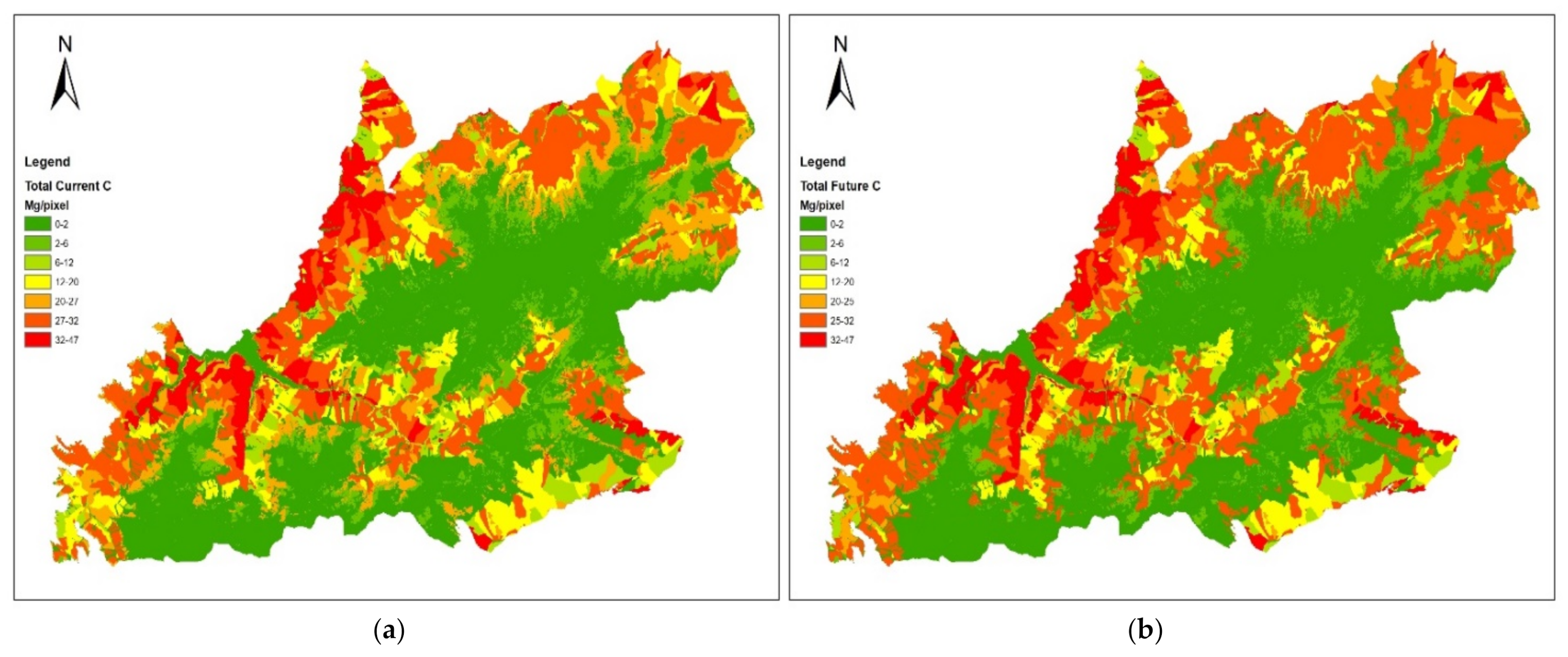
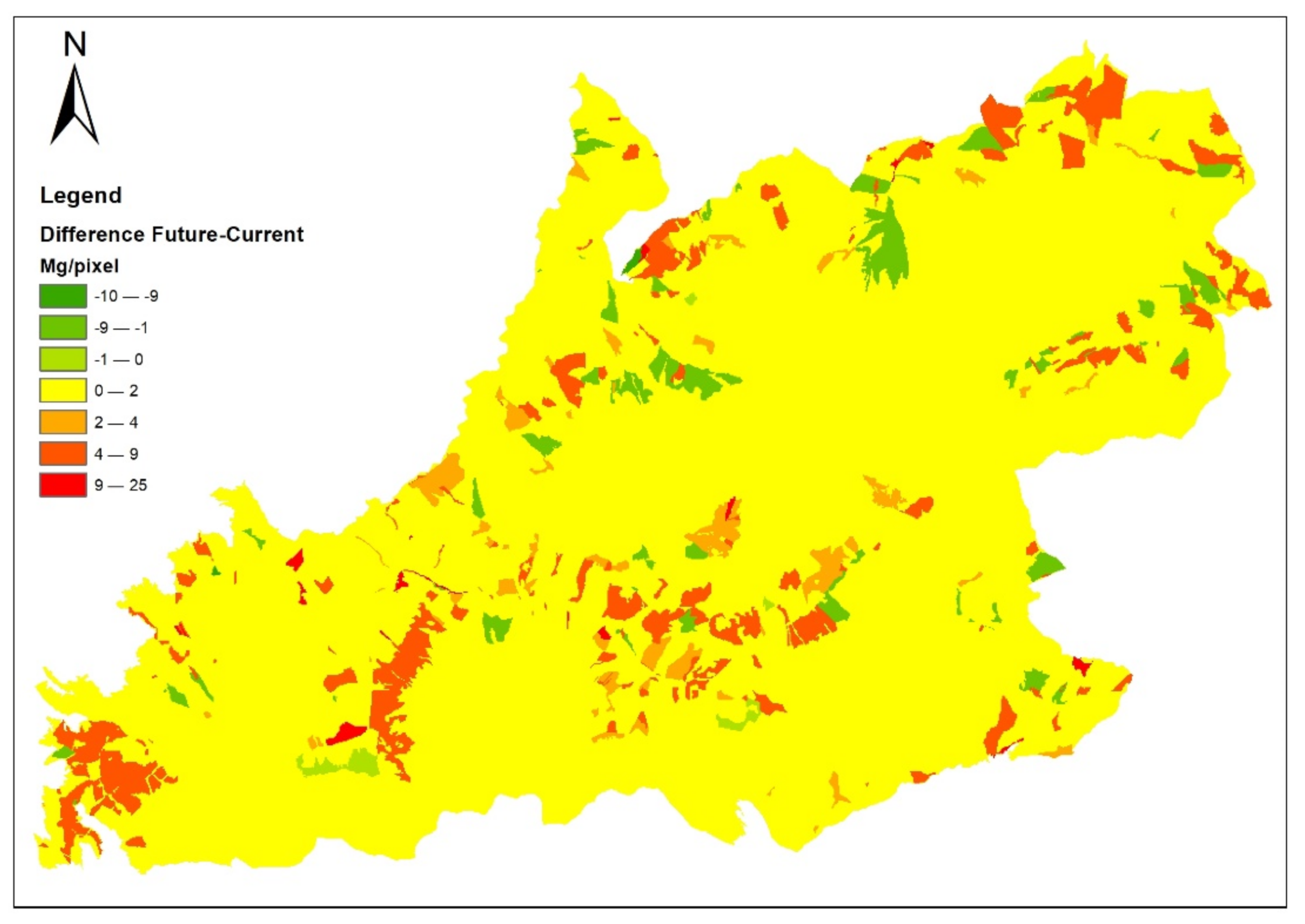
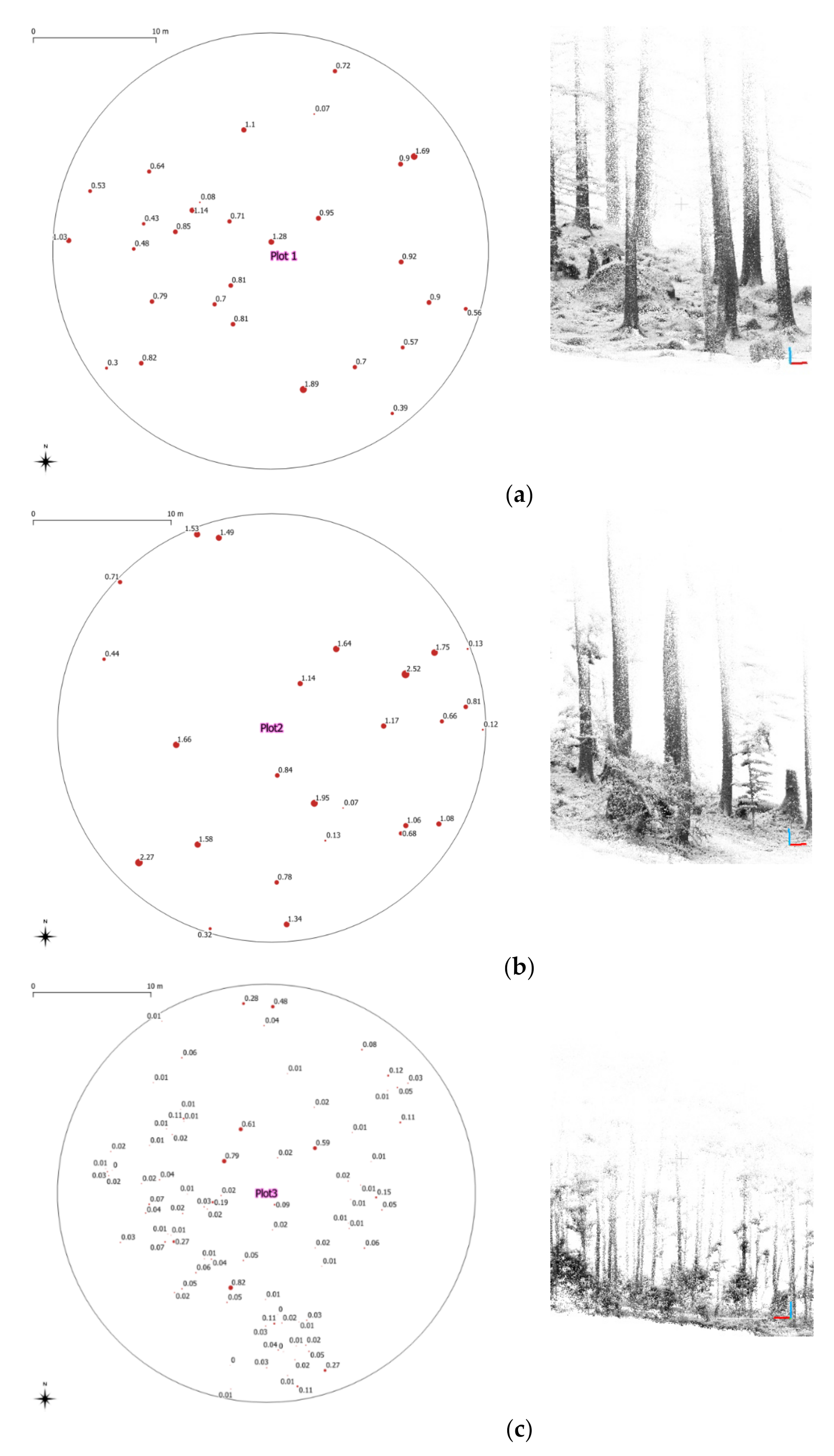
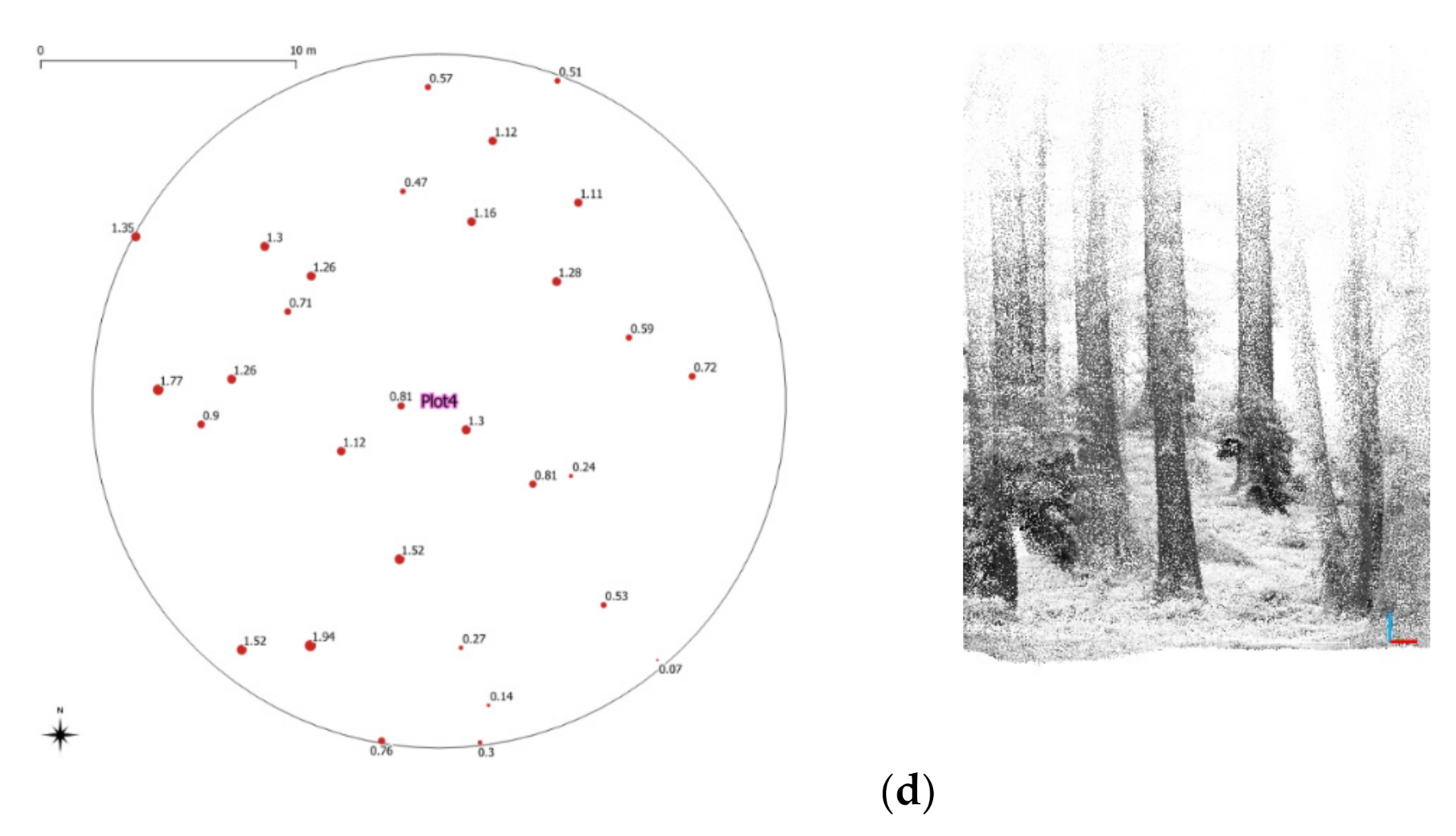
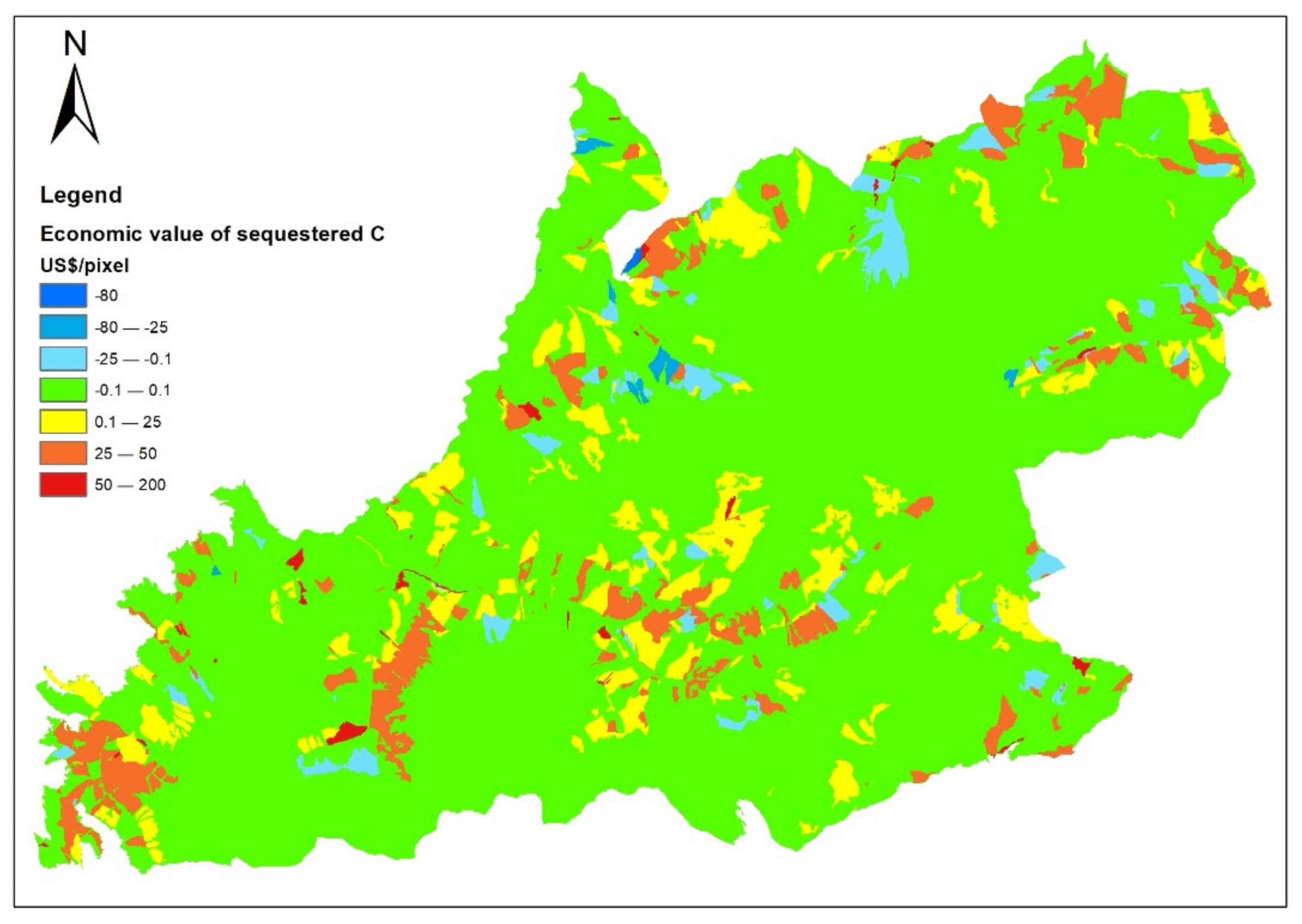
| Modeled Data | Value | Unit |
|---|---|---|
| Total current carbon | 6,021,295.25 | Mg of C |
| Total future carbon | 6,252,395.13 | Mg of C |
| Change in C for future | 231,099.98 | Mg of C |
| Net present value from current to future (3 US $/tCO2e) | 1,706,070.28 | USD |
| Net present value from current to future (60 US $/tCO2e) | 34,121,405.52 | USD |
| Descriptive Statistics | Plot 1 | Plot 2 | Plot 3 | Plot 4 | ||||
|---|---|---|---|---|---|---|---|---|
| DBH | Carbon kg | DBH | Carbon kg | DBH | Carbon kg | DBH | Carbon kg | |
| Mean | 0.52 | 784.61 | 0.58 | 1072.31 | 0.16 | 79.35 | 0.55 | 913.73 |
| St. Error | 0.03 | 74.08 | 0.04 | 132.96 | 0.01 | 17.27 | 0.03 | 89.46 |
| Median | 0.54 | 785.41 | 0.62 | 1070.41 | 0.12 | 20.32 | 0.56 | 856.75 |
| St. dev. | 0.14 | 398.93 | 0.21 | 677.95 | 0.10 | 159.26 | 0.16 | 490.01 |
| Sample Var. | 0.02 | 159,145.70 | 0.04 | 459,621.42 | 0.01 | 25,363.72 | 0.03 | 240,109.96 |
| Kurtosis | 1.36 | 1.63 | −0.60 | −0.59 | 5.06 | 11.44 | −0.38 | −0.73 |
| Skewness | −0.45 | 0.78 | −0.44 | 0.28 | 2.26 | 3.38 | −0.51 | 0.11 |
| Range | 0.62 | 1811.22 | 0.75 | 2455.52 | 0.49 | 818.16 | 0.63 | 1866.25 |
| Minimum | 0.19 | 74.21 | 0.18 | 66.72 | 0.06 | 2.27 | 0.19 | 73.26 |
| Maximum | 0.81 | 1885.43 | 0.93 | 2522.24 | 0.55 | 820.43 | 0.82 | 1939.50 |
| Sum | 15.04 | 22,753.70 | 15.18 | 27,880.06 | 13.42 | 6744.72 | 16.58 | 27,411.84 |
| No. of trees | 29 | 29 | 26 | 26 | 85 | 85 | 30 | 30 |
Publisher’s Note: MDPI stays neutral with regard to jurisdictional claims in published maps and institutional affiliations. |
© 2020 by the authors. Licensee MDPI, Basel, Switzerland. This article is an open access article distributed under the terms and conditions of the Creative Commons Attribution (CC BY) license (http://creativecommons.org/licenses/by/4.0/).
Share and Cite
Pache, R.-G.; Abrudan, I.V.; Niță, M.-D. Economic Valuation of Carbon Storage and Sequestration in Retezat National Park, Romania. Forests 2021, 12, 43. https://doi.org/10.3390/f12010043
Pache R-G, Abrudan IV, Niță M-D. Economic Valuation of Carbon Storage and Sequestration in Retezat National Park, Romania. Forests. 2021; 12(1):43. https://doi.org/10.3390/f12010043
Chicago/Turabian StylePache, Robert-George, Ioan Vasile Abrudan, and Mihai-Daniel Niță. 2021. "Economic Valuation of Carbon Storage and Sequestration in Retezat National Park, Romania" Forests 12, no. 1: 43. https://doi.org/10.3390/f12010043
APA StylePache, R.-G., Abrudan, I. V., & Niță, M.-D. (2021). Economic Valuation of Carbon Storage and Sequestration in Retezat National Park, Romania. Forests, 12(1), 43. https://doi.org/10.3390/f12010043






